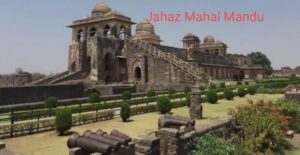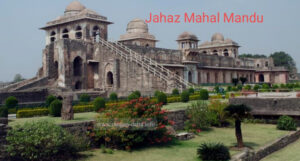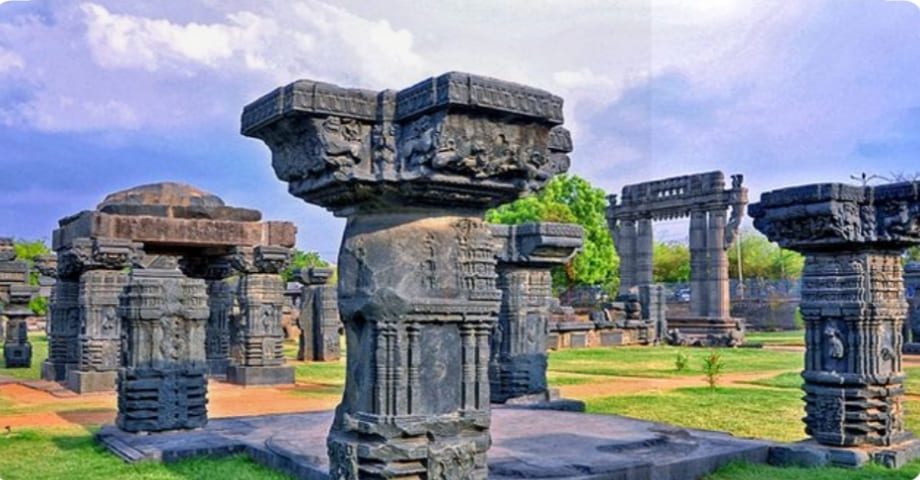Nestled in the ancient city of Mandu, Madhya Pradesh, lies a gem of medieval Indian architecture – the Jahaz Mahal mandu. Known for its unique boat-like structure, Jahaz Mahal, or the Ship Palace, is an exceptional testament to the grandeur of India’s Sultanate era. Overlooking the beautiful Munja and Kapur lakes, this palace appears to float like a majestic ship amidst the water, giving it a surreal charm that attracts travelers and history enthusiasts alike.
Built during the reign of Sultan Ghiyas -ud-din Khal ji in the 15th century, Jahaz Mahal holds great significance for both its architectural brilliance and historical importance. It served as a pleasure palace for the royal women and has become a symbol of Mandu’s glorious past. This blog will explore the rich history, architectural wonder, and the enduring appeal of Jahaz Mahal as one of India’s most cherished historical monuments.

1.History of Jahaz Mahal mandu
The history of Jahaz Mahal is intertwined with the reign of the Malwa Sultanate, particularly under the rule of Sultan Ghiyas- ud-din Khal ji, who is often credited with its construction. It is believed that Ghiyas- ud-din Khal ji built the palace as a harem for housing his vast collection of women, reportedly numbering over a thousand, including his wives and concubines. The palace was designed to cater to their comfort, entertainment, and luxury.
The 15th-century ruler was known for his opulent lifestyle and love for grandeur. Jahaz Mahal, in this sense, was not just an architectural feat but a statement of his wealth and power. Its unique design, with its reflection creating the illusion of a floating ship, adds to the mystique surrounding this royal retreat. The construction of Jahaz Mahal exemplifies the Sultan’s vision of creating a place that epitomized both pleasure and luxury for the royal household.
2. Jahaz Mahal Mandu: Architectural Features
The architectural beauty of Jahaz Mahal is a sight to behold. It stands between two artificial lakes – Munja and Kapur – which enhance its boat-like appearance. This location was carefully selected to give the illusion that the palace floats on water, resembling a ship in the middle of a serene lake.
The palace is a two-storied structure, with terraces on both levels offering panoramic views of the surrounding water bodies and the lush greenery. The architecture of Jahaz Mahal is an exquisite blend of Indo-Islamic styles, showcasing the influence of Persian design on Indian architecture during the Sultanate period.
Its slender profile, intricate jharo khas (overhanging balconies), and expansive halls create an aesthetic that is both regal and inviting. The palace is adorned with various chambers, courtyards, and rooftop pavilions that were designed for leisure and relaxation. The terraces were used for moonlit parties, while the open pavilions allowed cool breezes from the lakes to enter the palace, making it an ideal summer retreat.
The baths and fountains within the complex are some of the most remarkable features of Jahaz Mahal. These were strategically designed to maintain a cool and pleasant environment within the palace. The presence of water all around the structure, coupled with the fountains, created an air of serenity and opulence.

3.Purpose and Functionality
Jahaz Mahal was designed to serve as a harem, accommodating the numerous women of the royal household. It was primarily a place for leisure, recreation, and luxury living. The Sultan’s need to entertain and please his queens and concubines led to the creation of this magnificent pleasure palace, complete with all the amenities required for a royal lifestyle.
The palace was equipped with private baths, swimming pools, and fountains that allowed the residents to enjoy a lavish lifestyle. The vast courtyards, airy pavilions, and terraces were often used for evening gatherings, entertainment, and leisure activities. Jahaz Mahal’s design ensured that the occupants could enjoy the cooling effect of the lakes while being shielded from the intense heat of central India.
In addition to being a pleasure palace, Jahaz Mahal served as a symbol of the Sultan’s power and wealth. Its grandeur, location, and architecture were all intended to impress visitors and other members of the court. Today, the palace stands as a reminder of the opulence and excesses of the Malwa Sultanate.
4.Tourism and Significance Today
Jahaz Mahal continues to be a significant tourist attraction in Mandu, drawing thousands of visitors every year. Its unique structure, coupled with the surrounding landscape of lakes and gardens, makes it one of the most photographed historical sites in India.
Tourists visiting Jahaz Mahal can also explore other historical monuments in Mandu, such as the Hindola Mahal, Rani Roopmati Pavilion, and the Baz Bahadur Palace. The best time to visit Jahaz Mahal is during the monsoon season (July to September), when the lakes are full, and the palace truly resembles a ship floating on water. The cool breeze and the surrounding greenery enhance the beauty of the palace, making it an ideal spot for history buffs and architecture enthusiasts.
Efforts to preserve Jahaz Mahal are ongoing, with the Indian government and various heritage organizations taking steps to maintain and restore the structure. The Archaeological Survey of India (ASI) has been instrumental in preserving the monument, ensuring that its historical and architectural significance is passed on to future generations.
Conclusion:
Jahaz Mahal is more than just as historical monument – it is a symbol of India’s rich cultural and architectural heritage. Its unique design, stunning location, and historical significance make it a must-visit destination for anyone interested in India’s medieval history. As a floating palace that once served as a royal retreat, Jahaz Mahal continues to captivate the imagination of travelers from around the world. For those looking to explore the wonders of Mandu, Jahaz Mahal offers a glimpse into the opulent lifestyle of the Malwa sultans and the grandeur of India’s architectural past.
So, the next time you plan a trip to Madhya Pradesh, don’t miss the chance to witness the beauty of Jahaz Mahal – a floating palace that stands as a testament to Mandu’s royal legacy.
FAQ:
1.Who built the Jahaz Mahal in Mandu?
2.What is special about Jahaz Mahal?
3.Which ruler got the Jahaj Mahal of Mandu constructed?
4.Why is Mandu famous?
5.Jahaz mahal mandu entry fee
6.Jahaz Mahal of Mandu belongs to which age
7.Jahaz Mahal plan
8.Jahaz Mahal photos
9.Jahaz mahal mandu timing
10.Jahaz Mahal, Mandu architecture

